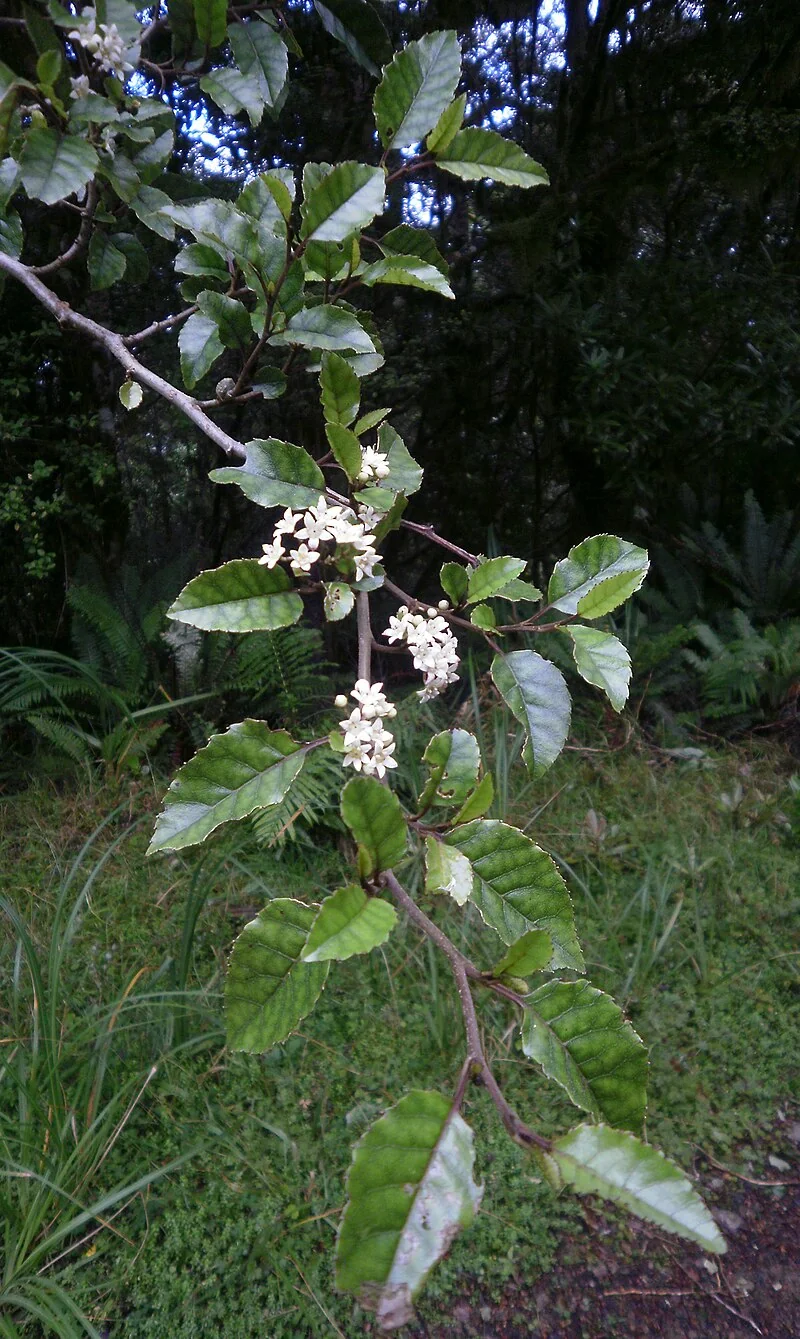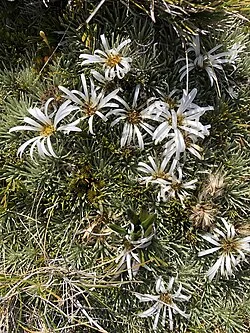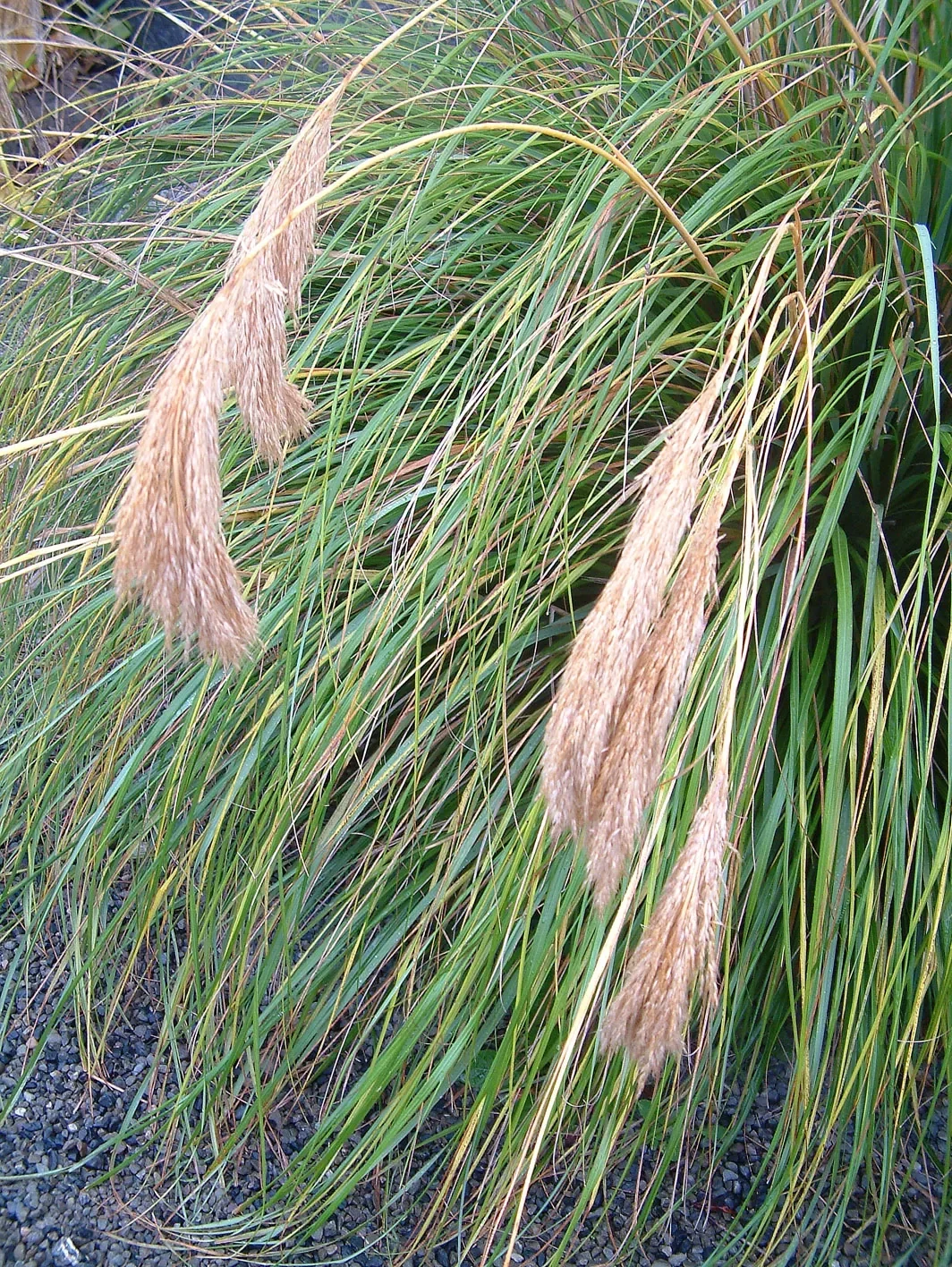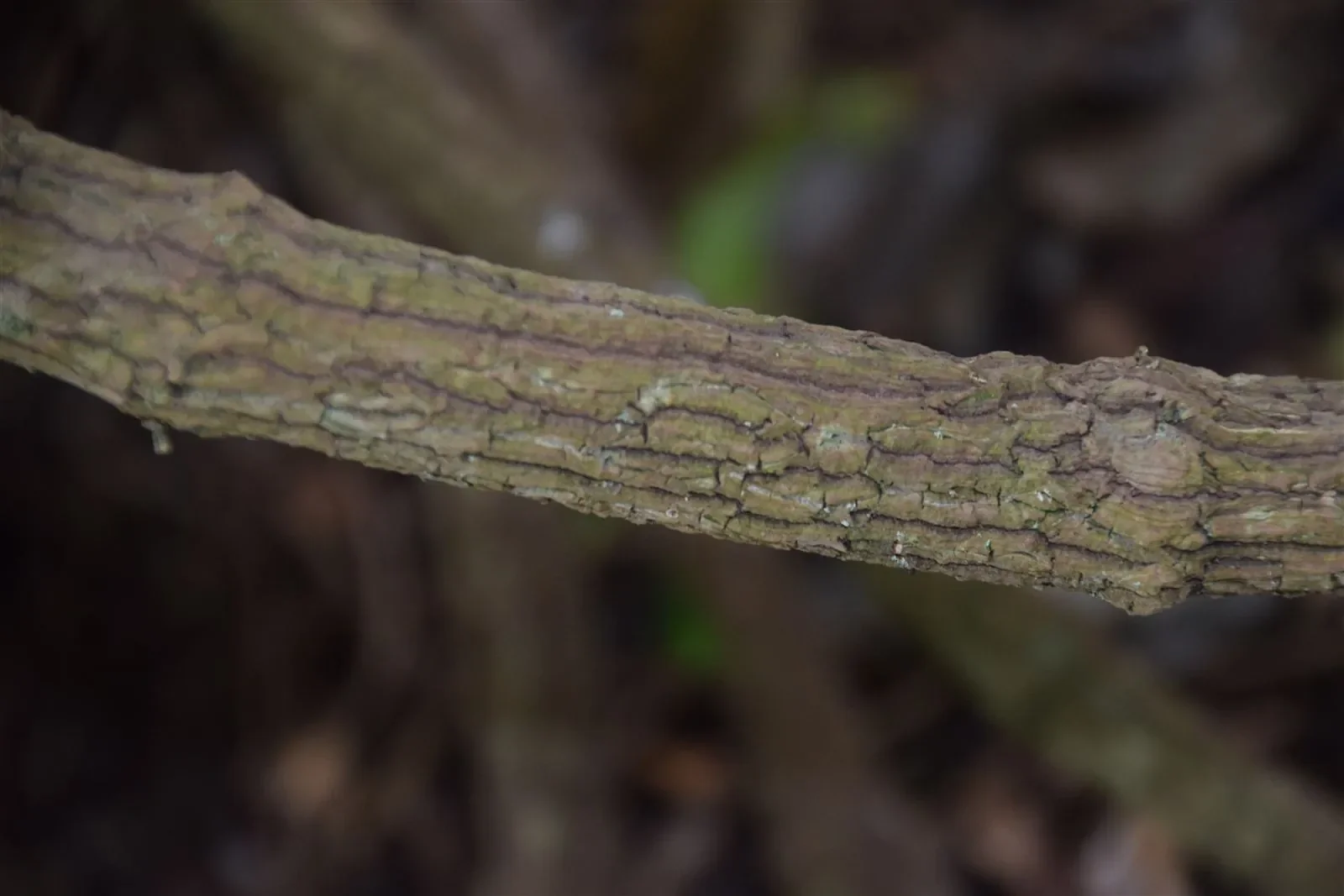
Marbleleaf
Carpodetus serratus
Introduction
Overview
Marbleleaf (Carpodetus serratus), also known by its Māori name Pūtaputawētā, is a distinctive native tree renowned for its remarkable leaf transformation and ecological importance. The juvenile form displays striking mottled or variegated foliage that creates a marbled appearance, while mature trees develop more uniform leaves and produce fragrant clusters of small white flowers followed by colorful berries. This versatile tree serves as a crucial host plant for native insects, including the puriri moth, and provides essential habitat and food sources for New Zealand's native bird species.

Marbleleaf, or Pūtaputawētā (Carpodetus serratus), is a small, evergreen tree native to New Zealand, renowned for its beautiful mottled leaves that resemble marble. It has a fascinating life cycle, starting as a dense, tangled shrub with a zigzag branching pattern, which persists for several years before it develops into a more upright tree. In spring, it is covered in masses of small, fragrant white flowers, followed by black berries that are attractive to birds among New Zealand's native trees.
Quick Facts
Key Plant Information
| Scientific Name | Carpodetus serratus |
|---|---|
| Common Name | Marbleleaf, Pūtaputawētā |
| Family | Rousseaceae |
| Height | 5-10 m |
| Spread | 3-4 m |
| Water Needs | Moderate to high, prefers moist soil |
| Light | Full sun to partial shade |
| Frost Tolerance | Moderate (young plants are frost tender) |
| Salt Tolerance | Low; requires protection from salt exposure |
| Growth Rate | Moderate |
| Lifespan | Long-lived |
Climate Best Suited to
Marbleleaf (Carpodetus serratus) is naturally found throughout New Zealand's forests from the North Island to the South Island. It thrives in temperate maritime climates with moderate to high rainfall and cool to warm temperatures. This adaptable tree performs best in areas with consistent moisture and protection from extreme weather conditions.
Regional Suitability
| City | Climate Suitability |
|---|---|
| Whangārei | Ideal |
| Auckland | Ideal |
| Hamilton | Ideal |
| Tauranga | Ideal |
| Rotorua | Ideal |
| Gisborne | Ideal |
| New Plymouth | Ideal |
| Napier | Ideal |
| Whanganui | Ideal |
| Palmerston North | Ideal |
| Wellington | Ideal |
| Nelson | Ideal |
| Christchurch | Ideal |
| Dunedin | Ideal |
| Invercargill | Ideal |
Natural Habitat
Distribution and Environment
Understand the natural habitat of Marbleleaf (Carpodetus serratus), including its geographical distribution, preferred environmental conditions, and the types of forest ecosystems where it thrives. This knowledge is crucial for replicating natural conditions in cultivation.
- Geographical distribution throughout New Zealand's North and South Islands.
- Preferred forest types from lowland to montane environments.
- Associated plant communities and typical forest companions.
Plant Conservation
Carpodetus serratus is currently classified as "Not Threatened" according to the New Zealand Threat Classification System, reflecting its relatively stable status across its natural range. This endemic species demonstrates resilience and adaptability, being found from coastal to montane areas (10-1000 m elevation) throughout the North, South, and Stewart Islands.
The species benefits from its wide distribution and habitat tolerance, thriving in moist broadleaf forests, beech forests, secondary growth areas, and forest margins. Its ability to regenerate in disturbed areas and establish along streamsides contributes to its conservation security. Marbleleaf also plays an important ecological role as a food source for native birds through its berries, supporting broader ecosystem health.
While not currently threatened, the species faces typical pressures common to New Zealand native forests, including habitat modification, browsing by introduced mammals, and competition from invasive plant species. Conservation efforts focus on protecting existing forest habitats and supporting forest restoration projects where Marbleleaf can naturally establish. The species' success in secondary forests makes it valuable for restoration initiatives, contributing to native biodiversity recovery in regenerating landscapes.
Growing Requirements
Soil Requirements
Marbleleaf prefers fertile, well-drained soil that is rich in organic matter. It can tolerate clay soils but good drainage is important. Adding compost when planting will help to provide the rich soil it enjoys.
Light Requirements
This adaptable tree can be grown in full sun or partial shade. In hotter climates, it benefits from some protection from the intense afternoon sun. In cooler parts of the country, it will thrive in a full sun position.
Water Requirements
It requires ample moisture, especially when young and during dry summer months. It is not a drought-tolerant plant. A good layer of mulch will help to conserve moisture and keep the roots cool.
Planting Guide
-
Best Time to Plant
Plant in autumn or spring. This allows the tree to establish its roots in mild conditions before the stress of summer or winter.
-
Choosing a Location
Choose a sheltered spot with moist, well-drained soil. It can be planted as a specimen tree or as part of a mixed native planting. Ensure adequate space for mature size.
-
Planting Steps
Dig a hole twice the size of the root ball. Add compost to the soil. Place the plant in the hole, ensuring it is at the same depth as in its pot. Backfill with enriched soil, firm gently, and water thoroughly.
Ecological Significance
Forest Ecosystem Role
Marbleleaf (Carpodetus serratus) plays a vital role in New Zealand's forest ecosystems, serving as both a direct provider of food and habitat and as a crucial link in complex ecological relationships involving native insects and wildlife.
- Berries provide important food for native birds including tūī, bellbirds, and kererū
- Flowers attract native pollinators and beneficial insects during spring
- Trunk holes created by pūriri moth caterpillars provide homes for wētā and other invertebrates
- Dense foliage offers nesting sites and shelter for small forest birds
- Important component of native forest understory and mid-canopy communities
Uses and Significance
Garden Uses
- Outstanding specimen tree for native plant gardens
- Perfect for creating multi-layered forest plantings
- Excellent for attracting native birds with its berries
- Ideal for woodland gardens and forest restoration projects
- Valuable for habitat creation and wildlife corridors
Landscaping Applications
Design Ideas and Integration
Discover how Marbleleaf (Carpodetus serratus) can be effectively integrated into various landscaping designs. This section offers creative ideas and practical advice for using this unique native tree to enhance the beauty and ecological value of your outdoor spaces.
- Design ideas for native forest gardens and woodland settings.
- Best uses in naturalistic plantings and habitat restoration projects.
- Combining with other native species for authentic forest communities.
Seasonal Care Calendar
Spring
This is the main flowering season. Ensure the plant is well-watered. A light trim after flowering can be done to maintain a compact shape. Apply organic mulch around the base to conserve moisture.
Summer
Continue to water regularly, especially in dry periods. The tree's beautiful marbled leaves provide great summer interest. Monitor for pūriri moth activity - this is a natural and beneficial process.
Autumn
Black berries will ripen, providing food for native birds. This is a good time to plant new trees. Collect seeds if you wish to propagate this fascinating species.
Winter
Young plants should be protected from heavy frosts. Once established, the tree is moderately frost hardy. Pruning to shape can be done in winter if needed.
When to Prune and How Much
Marbleleaf (Carpodetus serratus) requires minimal pruning to maintain its natural form and health. This tree naturally develops an attractive shape, progressing from its distinctive juvenile tangled form to a more upright mature tree.
- Light pruning after flowering in summer if shape adjustment is needed
- Remove any dead, damaged, or crossing branches at any time
- Allow the natural juvenile tangled growth phase to develop - this is normal
- Minimal intervention is best to preserve the tree's unique character
- Avoid heavy pruning which can stimulate excessive new growth
- Use clean, sharp tools to prevent disease transmission
The distinctive juvenile form with its tangled, zigzag branching is part of this tree's charm and should be appreciated rather than pruned away.
How to Grow Marbleleaf
From Seed
Marbleleaf (Carpodetus serratus) is most reliably raised from seed. Collect ripe black berries in autumn, macerate the fruit in water and rinse thoroughly to remove all pulp; the cleaned seed is very fine and benefits from careful handling. Fresh seed can germinate without treatment, but a brief cold period improves uniformity: mix seed with a little moist sand or vermiculite, seal, and cold-stratify at about 4°C for 4-6 weeks. Surface-sow onto a fine, free-draining seed-raising mix and barely cover with a dusting of sand or vermiculite; light aids germination, so avoid deep burial. Maintain gentle, even moisture (a spray mister helps) and provide bright light with good airflow at 15-20°C. Germination typically begins after 4-12 weeks and may be staggered. Prick out tiny seedlings promptly into individual tubes using a gritty, moisture-retentive but free-draining mix; keep shaded and sheltered while they establish. Harden off gradually, then plant out in well-drained soil with regular moisture and shelter from severe frost during the first winter.
From Semiâhardwood Cuttings
Cuttings can succeed with care but are generally slower and less reliable than seed. Take 6-8 cm semi-hardwood cuttings with a couple of small leaves in late spring through summer. Reduce leaf area to limit transpiration and make a clean basal cut just below a node. Treat with a rooting hormone (IBA 0.3-0.8%) and insert into a very free-draining medium such as 1:1 perlite and coarse sand or a fine bark-based mix. Provide bottom heat (18-22°C), high humidity (misting or a propagator dome), and bright, indirect light with good ventilation to prevent fungal issues. Keep the medium just moist; rooting may take 8-12+ weeks. Pot on carefully into a moisture-retentive yet free-draining mix and grow on in a sheltered, lightly shaded position before hardening off for planting.
Pests and Diseases
Marbleleaf (Carpodetus serratus) is generally a very healthy tree with excellent natural resistance to most pests and diseases. Its most notable "pest" is actually a beneficial native insect.
Beneficial Insects
- PÂāriri moth: Native moth caterpillars bore holes in the trunk - this is natural and doesn't harm the tree
- WtÂā habitat: The moth holes provide homes for native wētā, fulfilling the tree's ecological role
Common Issues
- Frost damage: Young plants can be damaged by severe frosts
- Drought stress: Inadequate watering can cause leaf drop and poor growth
- Root rot: Can occur in poorly drained soils
Prevention
The best approach is to provide optimal growing conditions: well-drained but moisture-retentive soil, protection from extreme weather for young plants, and adequate water during dry periods.
Cultural Significance
Marbleleaf, known as Pūtaputawētā by Māori, holds cultural significance due to its unique ecological role. The name translates to "many wētā emerge," referring to the native New Zealand insects (wētā) that often inhabit the hollow branches of the tree, sometimes created by PÂāriri moth caterpillars. This highlights the tree's importance in providing habitat for native fauna and its place in traditional Māori ecological knowledge.
Bonus Tip
Ecological Interconnections
The Māori name for Marbleleaf, "Pūtaputawētā," translates to "many wētā emerge." This refers to the native New Zealand insects (wētā) that often inhabit the hollow branches of the tree. These hollows are sometimes created by the caterpillars of the PÂāriri moth. This fascinating ecological relationship highlights the intricate connections within New Zealand's native ecosystems and the tree's role in providing habitat for unique native fauna.







